This is a gallery of photos featuring the broken records I have received over the past two years – a small percentage of the music that has arrived safe and sound. But still. Some aren’t that rare, some are quite possibly irreplaceable. There’s no point ranting about it again. The winner this year: the record that turned up in the mailbox wrapped once with a paper towel. This visual display should suffice in lieu of outward rage:
First row (l-r):
1. Auvergne cabrette solo, ca. early 1930s, hairline crack
2. Early West African high life, ca. mid-1930s, split in half
3. Spanish folk song from Navarro, ca. 1940s, cracked in half
Second row (l-r):
1. Asturian folk with gaita, ca. early 1930s, shattered
2. Several Brazilian folk records, ca. late 1940s, in pieces
3. Moroccan music, ca. mid-1940s, broken in half
Third row (l-r):
1. Lidya Mendoza record, ca. late 1930s, hairline crack
2. Cousin Emmy country record, late 40s, shattered
3. Canary Islands folk song, ca. 1940s, multiple cracks
Fourth row (l-r):
1. Nyanja music from Malawi, ca. 1940s, hairline crack
2. Flamenco by La Nina, ca. 1915-1920, cracked in half
3. Turkish female song, ca. 1928, hairline crack
Fifth row (l-r):
1. North Iranian/Central Asian music, ca. 1930s, in pieces
2. Galician bagpipe record, 1900s, multiple cracks
3. Tahitian music on Mareva label ca. 1940s, hairline crack
And last:
1. Galician bagpipe music, ca. 1910s, multiple cracks



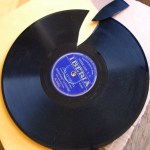



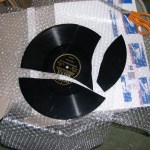

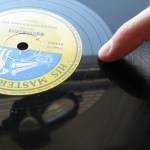


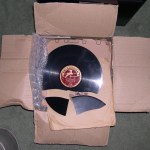


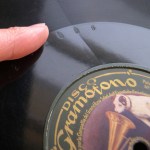
I bet it sucks to have to receive a broken record, but this little gallery sure is entertaining! At least for those of us that didn’t pay for the cracked vinyl. You should have crossed your fingers harder. 😉
Sigh, I know. A big issue is the fact that I’ve made sure that each person I buy records from understands the proper way to pack them…yet ignores that advice and packs them poorly, regardless. The money, thankfully, hasn’t been an issue, as I’ve been reimbursed for these. It’s the frustration of not being able to play the destroyed ones!
The sad thing is that the records will arrive safe every time if packed properly (assuming they’re not run over by a UPS truck or something), and proper packing is very easy to do…I’ve seen records packed in extremely elaborate packages that basically provide NO security. Sometimes it’s almost impossible to imagine the packer can think they’ve done a good job, as in the paper towel example. arrrgghh.
Too true, D – and I KNOW you know the feeling!
Did you manage to play any of those Jonathan? Several look quite salvageable to me….maybe you should have a stylus you’re not so nervous about for playing through cracks so you can at least make recordings of them?
Absolutely, Tony – I did not mention that. The ones that have hairline cracks are playable and I’ve recorded them already. (Those are, the French Pathé, the Nyanja record, and the Mendoza record.) Still, a cracked record is still, to me, crushing. The rest of the records pictured were total losses.
Ah yes, what a great post. Misery loves company- I’ve had a few moments like those, most recently being this one: http://i46.photobucket.com/albums/f126/petquality/brokenrecord.jpg
where the chowderhead seller merely folded two pieces of an overnight mailing envelope over the record and stuck it in a manilla envelope. Luckily it wasn’t a terribly rare disc, but the agony upon opening the package and seeing a record you’ve really looked forward to getting turned into a jigsaw puzzle is never fun.
Glad you were able to salvage at least a couple of the cracked items to play, anyway.
Might be an argument for one of those laser-based players, since they can, at least in theory, play back even cracked records (with noise).
If its an issue of an irreplaceable, one of a kind, it might be worth looking into…
From what I understand, those laser players are pretty useless when it comes to 78rpm records. Apparently they work well with 33s and 45s, though.
There are other, new methods of reading the grooves, such as the one they used to resurrect that snatch of audio from the 1850s in France recently, but I don’t think any of them are commercially available. As long as they’re not totally shattered, audio restoration might be possible.
Still, what a gut-punch to get a beautiful old 78 in the mail and not be able to play it.
there’s a really simple solution to this problem – when you agree to purchase a record, just tell the seller that you are sending them a pre-paid packing box. Then send them the correct packing material, in the correct configuration. It might cost a few extra $, but ultimately that’s better than having rare records destroyed…
I’ve done it many times, Toad, believe me. Usually it’s an extra $16-$20, as most of my stuff comes from overseas.
Have any of you tried the shellac crack repair methods described at http://78rpmrecord.com/repair.htm and if so how have they worked out for you? I’d like to hear from you before trying these out.
Not personally – not confident enough! Lots of people have tried them and there are wildly different opinions as to what works and what doesn’t. From what I understand, these methods can just as easily create disastrous results, so it’s best to test them on various worthless records first. Even better, if there is an expert repairer around who’s services you could engage. There is such a person in my area, but I have yet to hit him up for assistance.
Why couldn’t you just use a laser player to record them and just bump up the speed by a percentage (based on 33 or 45 rpm) to 78 using a cheap or free sound editor?
Rod
Hi Rod – As mentioned earlier in the comments, laser players really do not work properly on 78rpm records. They have laser players that play the speed, but it’s the results that are not acceptable. The groove surface of the 78 record is just not something a laser player can handle, from what I have been told. Much too complex. Plus, I mean, who HAS a laser player to even tinker with? No one I know!
It might also be a good time to mention that 78rpm was not a standard before a certain time period. Pre-1925, speeds are all over the map, depending on equipment, the record company, etc. In general,post 1925 or so, proper 78 playback is done at 78.26. Fun stuff!
Oh, I see. I thought you were referring to a speed problem that they have with them – and not an actual reading problem.
I’d like to take this opportunity to do some venting myself. It’s not as if people like us have some meeting we can go to for this (at least not one where anybody would understand just how sad it is that a 78 worth more than years of current music will never be heard again). I am familiar with the paper towel people. And I think I must have received my broken Brasilian Continentals from the same guy because they were cracked exactly the same way. He never sent replacements, though he lied and said he had. How do you say asshole in Portuguese? Even well-known world music collectors one assumes know how to pack after decades of doing this can let you down, sandwiching cracked 78s between moldy Beatles LPs in boxes that look like they’ve been fucked on by bums and then refusing to refund completely due to some secret superiority complex. Then there’s the mystery of a fine, bubblewrapped sandwich with a cracked record inside. How exactly does this happen? It’s amazing these 78s have survived a century of world wars but once they fall in the wrong hands it’s all over in a split second.
Methyl Ethyl Ketone (M.E.K.) available at many hardware stores fuses cracks on some post-war formulations but not others. I used to use an eyedropper but now use a very small brush. I do a test daub at the edge of the record. If it works there I run a small brushstroke along the crack then blow on it to make sure any excess evaporates immediately. Don’t use too much! It dries almost instantly. It’s fairly toxic so don’t inhale the fumes. Practice this on junk records til you get the hang of it. When it works correctly it is beautiful. As others have pointed out, it is essential to have the two sides of the crack aligned in the vertical plane or there will still be a tick or click.
Can you recomend a good company who can repair a crack on a 78rpm record? My aunt has a old record of my grandfather singing from the 30s.
Thank you for your time.
Joe
bard280@yahoo.com
There is no company that does such a thing, sadly. If you’re in the collector sphere, there are sometimes people who can do these things, but it’s a person-to-person thing, not a business. For basic info:
http://78rpmrecord.com/repair.htm
For the record – if you need to ship a 78rpm record, this is the standard, proper way to do so. There really are little to no substitutes for this method (though some people in the UK use an excellent styrofoam method). In fact, there are no excuses for not packing using this method in the areas of the world where the materials needed are readily available.
http://www.claxtonola.com/shipping78s/index.html
http://webpages.charter.net/kenmath/recordpacking.html
http://reviews.ebay.com/SHIPPING-78-RPM-RECORDS_W0QQugidZ10000000003856323
All well & good, but i am not finding any useful info on packing and shipping ONE 78 at a time, as for eBay listings. There is no way sellers are doing all this for $3 or $4 per record, including the USPS Media mail cost.
Mac – those 3 links are for shipping one 78 at a time, as well as several. In fact, it’s safer to ship multiple 78s than one, alone. I think 7 in one cardboard sandwich is safe.
Regarding prices – if it costs more for you, charge additional costs. Buyers understand this. Using the methods above it should be about $2.83 for Media Mail. A 12x12x6 or 12x12x5 box is maybe $1.50 depending on where you get it, plus maybe $1 max for 4 cardboard squares. Use old newspaper which is minimal cost. Many sellers charge a handling fee that covers the cost for shipping.
Thanks for the costs- there is a box place here & will check it out. Seems like a lot, but some of these records are supposedly valuable. But, nothing is consistent on eBay any more. Would be interested in just selling them all, if that was possible. They are more of a burden than pleasure any more. MJT
10x10x6 boxes available @ .49 per locally! Pretty good deal & a real surprise : )
You’re definitely going to want to use 12x12x6, since the records are 10″. Ideally, there should be at least 2″ of wiggle room on all sides of the cardboard sandwich.